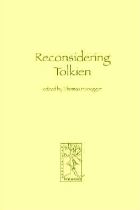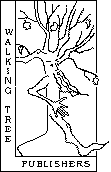Reconsidering Tolkien
Thomas Honegger (editor)
Cormarë Series No. 8

<--previous | all publications | next-->
how to buy this item
 Reconsidering the Linguistics of Middle-earth:
Reconsidering the Linguistics of Middle-earth:
Invented Languages and Other Linguistic Features in J.R.R. Tolkien's The Lord of the Rings
The languages of Tolkien's The Lord of the Rings have always fascinated scholars and other readers. Peter Jackson's film trilogy also picks up many of the linguistic devices and themes one encounters in the novel. The article seeks to explore the effects created by the linguistic evocations and the metalinguistic reflections both in the novel and in the films. The paper discusses the effects produced by the invented languages, which have played a particularly prominent role in linguistic approaches to Tolkien. Moreover, further linguistic aspects of The Lord of the Rings, such as linguistic variation on the regional, social, and individual level, reflections on the nature and origin of language, and the association of language with magic, will be addressed.
John Ronald Reuel Tolkien taught not only Anglo-Saxon and History of the English Language at the universities of Leeds and Oxford, but he was also a writer. Some think that, not being a 'professional' writer of fiction, he made many mistakes in the composition of his narratives. Yet the question arises, what 'professional writer' really means in this context? A producer of best- sellers maybe? If so, he was a great professional indeed. Many others think that the first one hundred or so pages of The Lord of the Rings are especially 'heavy' or 'hard reading'. However, it is not the purpose of this paper to analyse the reason of this lack of appreciation for the taste of words - which is what Tolkien mainly attempted. We will try rather to explain why, to many readers, Tolkien, and specially The Lord of the Rings, makes difficult reading - despite the fact that, to many of them, his are the books. That is why we will explore Tolkien's concept of the mythic, narrative value of words.
Tolkien Through the Eyes of a Mediaevalist
The Lord of the Rings, ever since its publication, has been something of a nuisance to traditional literary critics and has been maligned often and with zest. The main reason for these strong - and often irrational - reactions are primarily due to the fact that The Lord of the Rings does not fit into the literary mainstream and challenges standard critical assumptions about what a work of twentieth-century fiction should be like. The standard tool-kit of the literary critic seems utterly inadequate. Mediaevalists, in contrast, have often taken a more sympathetic view of Tolkien's work. My contribution will therefore present several 'mediaeval' approaches towards Tolkien, evaluate their critical value and discuss their contribution towards a more adequate understanding of Tolkien's literary work.
Thoughts on J.R.R. Tolkien's The Lord of the Rings and History
The Lord of the Rings is a work of fiction. Yet, Tolkien said that he 'wanted people simply to get inside this story and take it (in as sense) as actual history'. This essay examines what strategies are active in The Lord of the Rings that buttress the author's intention (and indeed the claims of the narrative itself) that it is a work of history. I start from the premise that philology in Tolkien's day was understood to be the fountainhead of cultural history. The Lord of the Rings invokes the Classical standard of an eyewitness, and the prologue and appendices strengthen the historical posture of the book by mimicking modern historical practices. The Lord of the Rings also blends Romantic and Enlightenment modes of historical writing. Finally, the book can be understood as a symbolic history and a genre of textual memory.
The Knife, the Sting and the Tooth:
Manifestations of Shadow in The Lord of the Rings
This paper will attempt an archetypal analysis of Tolkien's narrative in order to demonstrate the centrality of the motif of shadow, a mythological term adopted by Jung to refer to undesirable and suppressed aspects of both the personal and collective psyche. The paper focuses on Tolkien's treatment of this motif with a view to exposing cultural and anthropological implications of his work, as well as his concept of personal growth, as exemplified by his protagonist Frodo. It is demonstrated that the collective shadow contents of Tolkien's imaginary universe, which is predominantly patriarchal, originate in the projection of Thanatos and the hostility towards the daemonic, orgiastic (and hence disruptive) elements of the feminine. At the personal level, however, Tolkien is more hopeful and examines the prospect of integrating the shadow through the complex dynamic evolving between Frodo and Gollum as his Other. The process whereby this integration is achieved is gradual and the psychological experiences it entails - withdrawing projections, relinquishing the ideological constructs which justify animosity towards the Other, and recovering wholeness by recognizing the disowned portion of the Self - may all be discerned in Tolkien's novel.
Mythic Space in Tolkien's Work
(The Lord of the Rings, The Hobbit and The Silmarillion)
The recent filming of The Lord Of The Rings enabled neophytes to realize that one of the most down-to-earth and simultaneously enchanting aspects of Tolkien's universe was Middle-earth, the imaginary world that he created with faultless coherence both from a geographical and a historical standpoint. Yet if such coherence only worked at these two rational levels, would both the film watcher and the novel reader have been so powerfully entranced? Presumably not, insofar as only imagination and its medium - myth - are likely to involve so wide an audience. Once this is understood, we may ask how far Tolkien's space is mythic, but we shouldn't bring our questioning only this far, for then, we will also have to determine how this mythic essence leads to enchantment by delineating the concept of original space.
Language, Lore and Learning in The Lord of the Rings
A note of music is either right or wrong - absolutely! Not even Time can alter that: music is God's art. (Antonio Salieri in Peter Shaffer's Amadeus)
Within the framework of fantasy literature, aspects of magic may take on the garb of science and serve as functional explanations of the principles and laws by which the world is governed. This raises the question of how knowledge about the world and its natural laws is acquired, used, transmitted or hidden. Knowledge, of course, is inevitably connected with language, and the basically creationist origin of Tolkien's world indicates the existence of a true language with a non-arbitrary form of signification, the knowledge of which equals the knowledge of the world and its underlying principles. The quest for true knowledge then turns into a kind of archaeological endeavour, piecing together the fragments of ancient language and lore, while the search for new knowledge is inevitably destructive and thus linked to evil. This presentation of knowledge unquestionably adds to the internal coherence of the texts, but undermines all claims that Tolkien's work might offer useful solutions to pressing modern problems, as the premises of his fictional world and ours are ultimately irreconcilable.
The Lord of the Rings in the Wake of the Great War:
War, Poetry, Modernism, and Ironic Myth
This paper takes a look at the influence of World War I on the literary imagination in general, and on Tolkien's creations in particular. The aim is to take a closer look at an aspect of The Lord of the Rings which has not been much studied: its relationship to what Northrop Frye calls 'ironic myth'. For this purpose, Tolkien's best known work will be compared with some of the poetry written by poets who took part in the First World War, and with three well known writers of 'high modernism'.
Aragorn Seen Through Different Media
The release of the Peter Jackson film trilogy has renewed interest in both the original Lord of the Rings by Tolkien and in old and new adaptations of the book. Because of the film the character of Aragorn has, at least for the present-day film-going audience, become a prominent figure in Tolkien's Lord of the Rings. In this article I will illustrate how Aragorn is portrayed in the original work and how his character is shown in other versions across several media. As every medium has its own narrative techniques and technical limitations, I will use theories by Wendy Doniger and Northrop Frye to establish the fundamental elements of Aragorn's character. These will then be used to examine how well every adaptation has succeeded in portraying the essence of the character.
209 pages, Walking Tree Publishers 2005, Cormarë Series No. 8, Editor: Thomas Honegger, ISBN: 978-3-905703-00-9.

<--previous | all publications | next-->
how to buy this item

More on Reconsidering Tolkien

terms and conditions
visitors since 03.02.05
last updated 17.11.05
